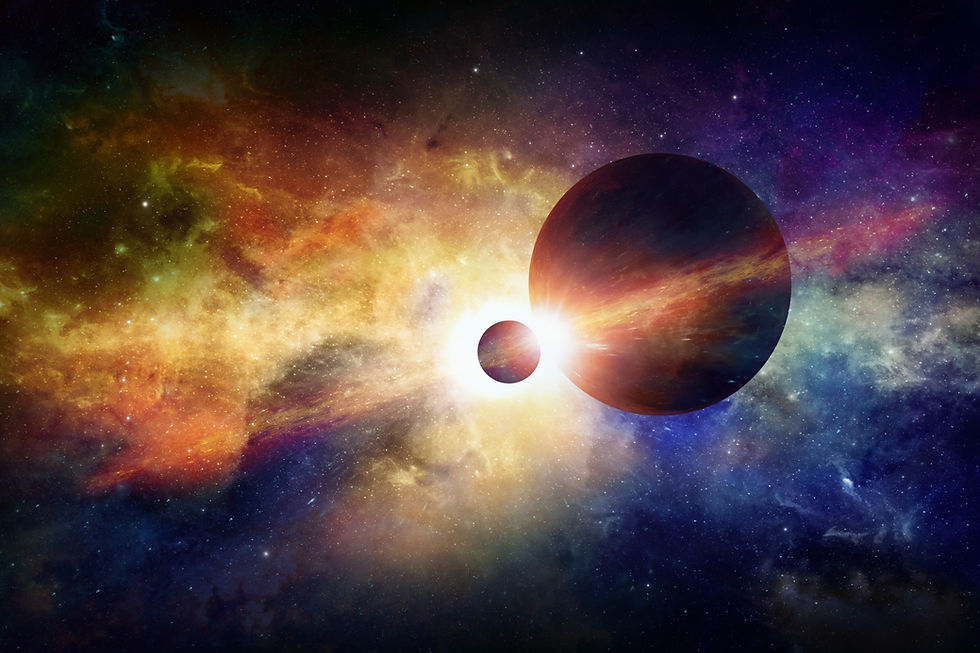SETTINGS - Part 1: 4 Aspects for Creating Settings in a Story or Novel
- M.L. Bull
- Sep 5, 2024
- 7 min read
Updated: Oct 3, 2024
As I mentioned in a previous post, settings help to "set the scene" and create a believable story world or environment within our stories and novels. Settings are essential elements to story writing because they allow writers to show to their readers exactly where their characters are located and invest them in as a part of the story world during their reading experience. Without settings, it would be extremely hard to set the scenes of stories and make story worlds realistic and interesting.
Remember, we as writers are typically creating an illusion of real life and painting images by the creative use of our words when we write our fictional stories and novels, and that can't be done on a blank, white canvas. So, grab your pencil and paper, pull out your typewriter, or open a new document on your computer, and as you write, build captivating and memorable settings to keep your readers' attention. How do writers do this? Well, there are four aspects for creating settings. These include place or locales, time, weather or climate, and seasons or occasions. Let's briefly look over each one of these below. 🔍

THE 4 ASPECTS FOR CREATING SETTINGS

🍕 1. PLACES or LOCALES
Place or locales are the most important aspects for creating settings. These set the stage and allow readers to become a part of our characters' story worlds. Places and locales are words that are used interchangeably; but in my opinion, there are differences between them. Places are the main locations or settings of the overall story, ranging from a particular state, town, country, island, or city. Whereas locales are sub locations or collections of smaller places within the main setting of our stories. For example, in my debut novel, Eva's Promise, Garden Ridge, North Carolina is the fictional town or main setting, while Sunrise Christian Daycare is a locale within the main setting of Garden Ridge in my story.
🍕 2. TIME
Time is another important aspect of settings, as it can cover many things. There are different types of time that exist in our real world and the same should be applied within our story worlds. These include time of day (dawn, morning, afternoon, night or dusk), dates (days of the week, months of the year), numeric time (time zones, hours, minutes, seconds, or years), and divisions of time (past, present, or future). Time can also be shown based on what point-of-view writers choose to write in, informing readers whether characters have already done something or doing actions at the present moment.

🍕 3. WEATHER or CLIMATE
Weather or climate are significant features for creating settings. These are like the cardboard props used for the scenery of a stage. Writers can get really creative with this aspect, as we all know there are different types of weather from sunny or partly cloudy skies to a violent thunderstorm or bitter, snowy blizzard. However, something I suggest writers also consider for weather or climate is to pay attention and describe details outside of those that are redundant. Most people know the sun is typically yellow and the grass is green, so make your descriptions standout in your stories.
Become an artist or a camera lens and create beautiful imagery and so readers can explore your characters' setting environments. For example, show readers how the weather affects your characters rather than just the weather itself. Describe how your character's fingers and toes have become numb on a cold, frigid night during a blizzard, or a chill that climbs up their spine while checking the mail on a windy, fall morning. Both of these are examples of how you can zoom into details that make readers become a part of your story world.
💡Tip #1: SET THE MOOD. Weather is a clever way to set the mood of dramatic or emotional scenes in your stories to draw your readers' attention and engross them in your story worlds. This can be done by your diction or word choice, using specific words that create imagery and add emotional significance to your characters' emotions or their story situations. For example, a rainy day or night can typically be used to set the mood for a character's state of depression or a sad scene, while a sunny afternoon can depict the mood for a character's state of joy or a happy or romantic scene in your stories. Although these types of weather referred to aren't always associated with certain emotions, the point is that using weather is a good writing technique to set the mood in scenes.
💡Tip #2: READ CRAFT BOOKS ABOUT SETTINGS. If you're a writer who struggles with setting descriptions, it can be extra helpful to read writing craft or reference books, such as the Urban and Rural Setting Thesauruses by authors Angela Ackerman and Becca Puglisi.
🍕 4. SEASONS or OCCASIONS
Seasons or occasions are the last aspects that add flavor to creating settings, if I can use this culinary reference. Aside from the annual seasons of spring, summer, fall, and winter, seasons or occasions can also be other times of the year, including special celebrations like Mother's Day, Thanksgiving, birthdays, or graduations. These different kinds of ceremonies can be great ways to set scenes within stories, as there's plenty of details to describe within them and how characters interact with them.
For annual seasons, there are also specific characteristics about each of them, which writers can use to paint colorful images of descriptions. For example, within autumn scenes we can describe the change of the color of trees, the scents of pumpkin spice or cinnamon, or characters raking and jumping in a pile of dried leaves. When writing seasonal or occasional scenes, also think about what you've experienced in real life and include sensory details in your writing while also "thinking outside-of-the-box." You might be surprised what you come up with from using your creative imagination.

BUILD YOUR SETTINGS LIKE A PIZZA

Imagine you're a chef and making a pizza. You have all of your ingredients gathered together on the kitchen counter and are prepared to create your masterpiece. You have your dough, tomato sauce, shredded cheese, and all of the toppings you want to decorate your delicious pizza. First, you knead and roll out your dough on a round tray. Next you add and spread out your tomato sauce over the dough. Then you sprinkle your cheese over your pizza, and finally you add toppings of pepperoni, sausage, peppers, or other veggies. Ladies and gentlemen, this is an analogy of building settings!
Settings consists primarily of some kind of places or locales. These are like the crusts of pizzas, where settings originate and provides a solid foundation where we set our scenes. Without them, it would be like our characters are floating around somewhere in empty space. Or other words, like trying to make a pizza without a landscape of crust to put it on. Next, we have time. This one is crucial to settings like sauce typically is to most pizzas.
As Marcus Aurelius quoted...
🗨️:
How soon will time cover all things...
Time is a fundamental aspect that determines the pacing of our stories and establishes when scenes are actually taking place within stories. Without time, we wouldn't know what time of day it is when scenes happen or be able to establish a passage of time in our stories.
The Merriam Dictionary defines time as the following...
🗨️:
The measured, or measurable period during which an action, process, or condition exists or continues: duration...
Just as tomato sauce covers the crust of pizza, time covers the entirety of the settings within our stories, allowing writers to distinguish and transition from one scene to another. Next, we have weather or climate. Cheese is a crucial ingredient to a typical pizza, just as weather and climate are to establish a sense of illusion to real life. Like cheese sprinkled on a pizza, writers can trickle in descriptions of the weather to set the mood and create an atmosphere, such as drizzling rain on a spring day or dappled sunlight through the leaves of trees on a summer afternoon.
And lastly, there's seasons or occasions. We can use various different toppings to decorate pizzas and seasons and occasions can do the same when we build our settings. Whether we describe one of the four annual seasons of summer, fall, winter, or spring, or different kinds of occasions that are taking place, such as Independence Day, both of these can be used creatively to form believable scenes and embellish our stories.
ASK QUESTIONS TO SET THE SCENES

Something that can also help writers when setting scenes is asking questions. For example, what is the main location or setting in the story? Is it in a particular city, island, or country? Where does the scene take place? What time is it? Is it day? Maybe night? What is the weather like? How does the weather play a significant role in the scene's mood? What season is it? And is there a special occasion taking place? All of these questions and others are like building bricks that help writers create settings and put them together. I know the above analogy might've been a little bizarre, but if you're a writer who struggles with setting descriptions; next time, maybe think of building settings like building a pizza and ask yourself detailed questions to help you set your scenes.
CLOSING REMARKS:
Setting descriptions can sometimes be the toughest for writers to describe compared to characters because it involves an entire story world that we have to make realistic and believable to our readers. In essence, we writers become like "creative gods" when building our fictional story worlds and settings, and that's a big undertaking.
As American author Sidney Sheldon quoted...
🗨️:
"A blank piece of paper is God's way of telling us how hard it is to be God."
At least, for us as writers. But if we utilize the four aspects of places, time, weather, and seasons or occasions, we can easily set the scenes in our story worlds and create locales that pull readers into our stories and keep their attention to the very end of our books. All right, that's all for this post. If you found it helpful to you, please, give it a (heart❤️), take part in the poll🤔, and share your thoughts or comments 💬 below.)
Happy Writing! 😊✍🏽💻
🤔What's your favorite kind of pizza listed below?
🍖Meat Lover's
🧀Cheese
🥬Veggie
🍍Ham and Pineapple










Comments